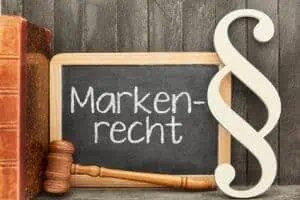Trademark infringement: Helpful tips for professional handling
There are currently more than 815,000 different brand names registered at the German Patent and Trademark Office, and new entries are added every day.
Due to this large number, it is not surprising that certain trademarks and brand names are misused again and again - either by mistake or on purpose.
But what is a trademark infringement and what can injured parties and infringers do in such a case?
Detailed information and further hints and tips can be found in this article!
Content
1. What is trademark infringement?
2. What can I do if a third party infringes my trademark?
3. What does a warning contain?
4. What do I have to do if the warning is justified?
5. What if the warning is not justified?
6. Trademark infringement: what costs will I incur?
7. How is the damage calculated?
8. How can an intellectual property lawyer help with trademark infringement?
1. What is trademark infringement?
The registration of a trademark grants the trademark owner an exclusive right to use this trademark. This protection is limited both geographically to the respective scope of the brand and in terms of content to the individual protected classes of goods or services.
If an identical sign is used for similar products, there is always a trademark infringement.
Trademark infringement occurs whenever a third party uses a sign identical to the protected trademark to sell equivalent goods or services. Selling computers and cell phones under the English name for apple would therefore not be a good idea. In principle, however, it is permissible to use a protected trademark in a different class.
Particular case: Likelihood of confusion
A trademark infringement may exist even if there is no identical infringement. However, this becomes problematic if both goods are similar. In addition to equal use of their trademark, the owner is protected against the risk of confusion.
As a rule, it is not sufficient to make only minor changes to an existing trademark. Even one's products do not have to be identical to those for which the infringed trademark enjoys protection. However, the brand names and the products must be so similar that a so-called likelihood of confusion is added. The decisive question is therefore often:
If a potential customer were to assume that the goods sold come from the same company, this would indicate a likelihood of confusion.
However, a trademark infringement can only ever occur in business dealings. A trademark infringement is excluded in the case of actions in the private sphere. As is so often the case, however, the boundaries between personal and business activities are fluid.
Thus, the "private" purchase of 2 identical, alleged branded sweaters may already indicate a commercial activity. After all, it seems rather unusual to buy several similar items for private use. This question is particularly relevant in the case of "private" sales via online platforms, especially if the seller can show a high number of ratings and sales.
2. What can I do if a third party infringes my trademark?
First of all, it is advisable to secure appropriate evidence. After all, in the event of subsequent legal proceedings, the trademark owner must present and, if necessary, prove that his trademark has been infringed. In practice, it is therefore a good idea to secure the relevant websites. Test purchases are also an effective means. You should document the exact course of the purchase well.

In addition, it should be investigated whether the other party itself has a registered trademark. This can be done by conducting a corresponding search at the relevant trademark offices.
Often, a particular uncertainty about whether an infringement exists at all or whether the other party does not have good reasons to use this trademark cannot be eliminated. In this case, it is advisable to refrain from issuing a warning notice with costs for the time being. Instead, a so-called authorization request should be made. With this request, the other party is informed about a possible trademark infringement.
In addition, the other party is requested to state the legal basis on which the trademark is being used.
If the other party does not respond or the reasons given for the allegedly lawful use are not valid, the next recommended step is to issue a warning. Although there is no obligation to hire a lawyer, a warning notice should never be given prematurely or on one's initiative.
If there is a suspicion that a trademark infringement has been committed, it is advisable to contact a competent specialist attorney for industrial property rights.
The latter can then check whether a trademark infringement has occurred. If a trademark infringement is wrongly declared, there is the threat of further trouble. The incorrectly warned party can demand that the costs of his lawyer be reimbursed.
If the suspicion of a trademark infringement is substantiated, the lawyer will draft a warning letter and send it to the other party.
3. What does a warning contain?
Warning letters are usually structured in the same way. First, the party issuing the warning is named. Explanations of the alleged infringement follow this. As a rule, reference is made to one or more existing trademarks, and it is stated when and for which class these were registered.
Subsequently, the trademark infringement must be explained, in other words, which specific action is being attacked, and why this constitutes a trademark infringement in the opinion of the party issuing the warning.
Often, legal explanations follow. This is especially recommended if there is no identical infringement but the only similarity between the two signs.
After these explanations, it is communicated which measures the warned recipient must now take from the author's point of view. The most important measures are the removal/stopping of the infringement and the reimbursement of the warning costs.
Lawyer-advised warning letters will also already attach a drafted cease-and-desist declaration.
4. What do I have to do if the warning is justified?
If the warning proves to be justified, the infringing act should be stopped immediately. For example, you must stop selling the product. In addition, the infringed trademark owner can demand that the respective products be destroyed.
It is never enough just to stop the violation!
In addition, they are obliged to ensure that no further infringements occur in the future. The warning party does not have to be content with mere declarations of intent. Instead, he can (and will) insist on submitting a cease-and-desist statement with a penalty clause. This and only this is suitable to eliminate the so-called danger of repetition in a legally effective manner.
It is assumed that whoever infringes a trademark once will do so again.
This cease-and-desist declaration is a binding declaration to refrain from further infringements. The statement is also accompanied by the willingness to pay a contractual penalty in the event of another violation.
Contractual penalties of € 5,000+ are not uncommon!
The deadline set for the submission of the cease-and-desist declaration in the warning letter should be strictly observed. If the order is not received by the deadline, there is a risk of further trouble. The warning party can then apply for an injunction and file a lawsuit. This is followed by court proceedings that are just as expensive as they are avoidable.
The defendant is also informed in the warning that legal action will be taken against him if he does not comply with the demands within the time limit.
We answer your questions about trademark infringement
Call us now on under 040 3501 6360 or write an e-mail to info@kanzlei-bennek.de.
5. What if the warning is not justified?
Even if the warning proves to be unjustified, it should not be ignored.
As a rule, it is advisable first to show the other party why the warning is unjustified. If the other party proves to be reasonable, further proceedings can be avoided.
In the case of so-called unjustified warnings, the warning party must bear the costs of its lawyer.
Due to the complexity of trademark infringements, it is a unique feature that in the case of an unjustified warning (so-called unjustified trademark warning), the warning party must also bear the extrajudicial costs of the opposing attorney.
On the other hand, if the opposing party insists on its legal opinion, it will generally apply for a temporary injunction. The competent court can issue a temporary injunction without having heard the other party beforehand. This means that, in the worst case, the court does not even know that there are justified doubts about the warning.
The filing of a protective brief can be done quickly and relatively uncomplicated online via the central protective brief register.
The best way to counter this is to file a protective letter. This is then filed with the relevant court. Before issuing an order, the court checks whether protective writs have been filed. If this is the case, it will consider its arguments.
6. Trademark infringement: what costs will I incur?
Trademark infringement is expensive.
This already results from the amounts in dispute determined by the courts. For example, it is recognized that even the infringement of a registered but unknown trademark can justify an amount in controversy of €50,000. The better known or more used the brand is, the higher the amount in dispute will be.
Dispute values of € 250,000-500,000 are not uncommon in trademark cases.
However, these amounts in dispute are only used to calculate court and attorney fees. They, therefore, do not have to be paid. However, the high parts in conflict mean that legal fees of €1,000-2,000 are already incurred for the (out-of-court) warning letter, and court proceedings readily devour litigation costs of several thousand euros.
In addition to the warning and possible legal costs, there is the threat of further trouble. The infringer can demand that the entire production be destroyed and that the resulting damage be compensated.
7. How to calculate the damage
When calculating the damage, the injured party can choose between three calculation methods. They can freely decide between
- the compensation of the lost profit,
- the payment of an appropriate license fee (so-called license analogy) or
- the surrender of the so-called infringer's profit.
In trademark cases, damages are calculated primarily according to the so-called license analogy. This is done as if the infringer had agreed on a license fee with the trademark owner before his action. An appropriate license fee is then to be paid.
As a rule, there are differing opinions as to the amount of such a fee. If the infringed party has already concluded license agreements with other companies in comparable cases, these can be used to determine the amount. Otherwise, a license is specified by taking into account, among other things, the awareness and reputation of the infringed trademark and the duration of the infringing act.
Royalties of at least 1-4% of sales are considered customary.
To ensure to assess their claims better, the infringed party is also entitled to extensive information claims. For example, they can demand information about distribution channels, sales figures, or even the manufacturer. These are all data that you would not want to disclose to a potential competitor.
8. How can an intellectual property lawyer help with trademark infringement?
As a specialist attorney for industrial property rights, I have special theoretical training and practical experience in trademark matters.
The assessment of whether or not a trademark has been infringed is very complex. Case law has developed many criteria for this, which must be evaluated individually and then weighed against each other.
If you want to take legal action against a trademark infringement, I first check the chances of success. Then, together with you, I will develop a suitable strategy, from an authorization request to issuing a warning letter. In the event of a legal dispute, I will represent your rights before the competent courts nationwide.
If, on the other hand, you receive a warning yourself, I will work with you to develop a suitable defense strategy. I will negotiate with the other party and draft a modified cease-and-desist declaration. In doing so, it is often possible to significantly reduce the demanded cease-and-desist letter and claims for damages.
If, on the other hand, the warning proves to be unjustified, I will reject the warning on your behalf, prepare a protective letter for you and represent you before the competent courts.
Do you have further questions about trademark infringement, or would you like to make an appointment?
Call us now on under 040 3501 6360 or write an e-mail to info@kanzlei-bennek.de.
Image source: Robert Kneschke - fotolia.com



